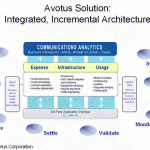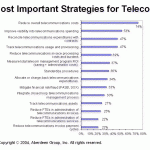Technology-enabled business process outsourcing solutions in recent years have optimized several complex, cost-laden enterprise functions. ERP systems, for instance, now manage supply chain functionality; CRM technology enables better interaction with customers and more holistic relevancy to their data; and eProcurement systems can achieve cost-effective sourcing. But one costly enterprise functional area–the expense side of voice and data communications (which many industry studies reveal is typically the third or fourth largest operating expense for most companies)–has not been managed in a rational way…until now.
Although dozens of software suppliers and niche services providers in the communications space help customers with call accounting, infrastructure management, or expense management, they provided only fragmented solutions until recently. Today, the industry is in the early–yet quickly accelerating–stages of integrating such vertical models into a unified model–Total Communications Management (TCM)–for managing all of the business processes revolving around communications. [TCM is also known by several other names: Gartner refers to it as Telecom Expense Management (TEM), and Aberdeen Group calls it Total Telecom Cost Management (TTCM).]
“Companies know they have a pain point revolving around communications,” states Alan Gold, Senior Vice President of Marketing and Corporate Strategy for AvotusÆ Corporation, a leading services provider in the communications space. “Auditors doing manual spot checks and subsequently raising red flags have made the problem visible to executives, and they’re now getting a strong sense of the order of magnitude associated with the problem.”
Gold says an average large enterprise, for instance, can receive up to 15,000 communications invoices annually. Often accounting departments, wrestling with reconciling monthly bills encompassing plans differing in various regions of the world, simply pay on trend and approve invoices if they are within a 10-percent trend margin (thus perpetuating any errors). Putting the magnitude into further perspective, Gold cites one company’s discovery that its carrier had continually mischarged the company over the negotiated rate by two-tenths of one cent per call. “Multiply that fraction over the company’s nearly 300 million billed calls in the course of a year, and that’s a huge amount of money,” he points out. Unfortunately, some carriers have restrictive contracts requiring that disputes be identified within 45 days of the invoice.
Another company–handling expenses for its 8,000 mobile phones–discovered it took six months to close the loop on expenses continuing for a terminated employee’s phone. “Wireless is usually accounted for in expense reports or other decentralized methods,” says Gold. “How can you capture those expenses when people travel a lot and don’t get their expense reports in until weeks or even months later? A good-sized company is probably under-reporting to the tune of millions of dollars.”
Referencing various industry analyst reports, Gold cites statistics stating 85 percent of businesses do not audit their bills (missing 7-12 percent in over-billed charges and overspending by as much as 45 percent), and 90 percent do not have visibility into their wireless spending. Moreover, toll fraud hacking into corporate telecom networks is estimated to cost more than $1 billion annually.
Gold also refers to industry reports that suggest an enterprise that has moved a data center (and who hasn’t these days?) has a 90 percent chance of paying for infrastructure it no longer has. “For many companies, it’s nearly impossible to even understand what they have, let alone manage the use of it and then make sure they have actually optimized on the expense side,” he states. Having little visibility into communications spend is a real nightmare for CFOs, who are now required by the Sarbanes-Oxley Act to attest to the accuracy of enterprise expenses.
The magnitude of the problem has been building up, Gold explains. Globalization initiatives and, more specifically, decentralization of the workforce (and proliferation of mobile devices), as well as merger/acquisition activity and consolidations have all come together and created a situation where companies no longer have good control over their physical infrastructure. But companies’ tremendous pressure to cut costs is the primary reason for recent attention drawn to visibility into the problem.
Outsourcing Enables a Dynamic New Management Model
A Total Communications Management model not only squeezes costs out but also optimizes the business environment. Like a plant, an enterprise communications environment has tendrils twisting around into three business process areas:
- Expense management (controlling costs of procuring the infrastructure, assessing accuracy of invoices, assessing best practices/policies, etc.)
- Infrastructure management (system administration of the switches, operating the help/trouble desk, handling moves/adds/changes, etc.)
- Usage management (call accounting including tracking proper usage, allocation of call expenses back to proper departments, etc.)
This fragmented environment causes enterprises to approach the problem from different perspectives. The IT organization (which, in many enterprises includes the communications or networks group) looks at optimizing the infrastructure components. The finance organization, responsible for procurement and expense management, often looks for cost-reduction opportunities in usage and expense. Gold also points to a developing area growing in popularity and value in many midsize and large companies–IT Finance. This group looks for opportunities to cost optimize technology infrastructures. Then there are the auditors. All of these groups come at the communications management problem with best-practice ideas for their responsibility areas, those parts of the business with which they are most familiar.
Similarly, the service providers’ offerings historically have taken a fragmented approach (described as outsourcing with a small “o,” says Gold). While this bits-and-pieces approach to a business solution can save time and money in processing invoices, for instance, it does not envelop enough critical mass to achieve synergies and optimize the communications environment.
But the market is now consolidating and integrating the vertical models (Outsourcing with a capital “O”). Illustrating what is now happening in the communications provider space, Avotus is the result of a merger several years ago of a company focused on call accounting and a company providing system administration and switch management. Add a software platform and expense management expertise (as illustrated in Figure 1), and you have a compelling value proposition for customers, which Avotus describes as its “Intelligent Communications Management” (ICM).
Optimizing an enterprise communications environment not only requires technology-enabled processes but also skills sets/expertise in managing each of the three fragmented areas (expense, infrastructure, and usage)–and integrating that management.
As Figure 1 shows, ICM is based on the three management-areas pillars, which rest on a foundation that is integrated with enterprise business processes (such as CRM and HR). Avotus will soon add a fourth pillar–procurement. Thus, the ICM model creates a single, actionable environment that enables Avotus customers to bring together decision-critical information about systems usage, infrastructure, and communications expenses.
Aberdeen Group Recommendations
Analyst firm Aberdeen Group, Inc. actively studies enterprise telecom spend management. Its report, “Spend under Control Key to Cost Savings,” cites findings and conclusions from a survey of companies in North America, EMEA, Latin/South America, and Asia/Pacific about their telecom spend management activities. Small businesses (annual revenues under US$50 million) comprised 47 percent of the respondents; 29 percent were midsize enterprises (annual revenues between US$50 million and $1 billion); and 25 percent were large enterprises (annual revenues over US$1 billion). Aberdeen Group observed the top strategies for companies seeking to better manage their telecommunications expenses included the key steps outlined in Figure 2.
An additional enterprise recommendation in the Aberdeen Group report is to “consider a business process outsourcer to support your efforts if telecommunications is a non-core category.” (The entire report is available at no cost at www.aberdeen.com/ttcm.)
ROI from the New Outsourced Total Management Solution
Total Communications Management is more than a technology underpinning. This business process outsourcing (BPO) solution achieves hard-dollar savings, ongoing soft cost reductions through process cycle improvement, usage optimization, and an audit trail for Sarbanes-Oxley purposes. Although buyers are rapidly adopting the outsourced TCM model, there are less than a handful of service providers that currently offer this leading-edge solution.
Avotus is one of them. Currently, over 3,000 customers around the world enjoy returns of as much as 500 percent on their investments within months (in some cases, in just weeks) through solutions provided by Avotus and its partners (Avaya, Cisco, and Nortel). This dramatic ROI depends on the magnitude of the customer’s problem.
Flexibility is already available for enterprises that adopt this BPO solution. Avotus, for instance, offers three models:
- Standard hosting model (services on a subscription basis)
- Advantage model (a hybrid where the provider loads invoices, does the data connections and uploading/downloading of information, while the customer enterprise staff manages other functions)
- Elite model (fully outsourced solution, with control, responsibility and risk for resources and expertise resting in Avotus; this solution has an additional payback in that it allows the customer enterprise to redeploy its people in core-business functions)
The third model includes handling the complexities of migrating to VoIP or a mixed environment. Following migration, the solution manages usage, capturing packet loss, delays and error messages that result in carrier reimbursements; it also manages cost and allocation and appropriate use (who is calling whom/where around the world and for how long).
Avotus’ solution-build process begins with an assessment to identify and prioritize a customer’s opportunities for savings. Implementation is incremental, with some parts up and running in 30 days.
For companies that have already outsourced their IT infrastructure, a TCM service provider becomes a subcontractor to the existing IT outsourcer, providing a symbiotic, value-added functionality to the management of the IT infrastructure.
Strategic Value
As Gold points out, an outsourced solution for Total Communications Management is the ideal solution for executives facing the balancing act between tactical and strategic investments. On the tactical side, it provides immediate relief with cost reduction and creates a logical, more efficient environment. On the strategic side, it builds a larger context for changes that wind up providing a long-term focus for optimizing the company’s business.
Thus, with a low-risk, high-value-return solution, the outsourcing industry is evolving to a model that provides a compelling tactical solution to a strategic problem.
About the Author: Ben Trowbridge is an accomplished Outsourcing Consultant with extensive experience in outsourcing and managed services. As a former EY Partner and CEO of Alsbridge, he built successful practices in Transformational Outsourcing, Managed services provider, strategic sourcing, BPO, Cybersecurity Managed Services, and IT Outsourcing. Throughout his career, Ben has advised a broad range of clients on outsourcing and global business services strategy and transactions. As the current CEO of the Outsourcing Center, he provides invaluable insights and guidance to buyers and managed services executives. Contact him at ben.trowbridge@outsourcingcenter.com.

